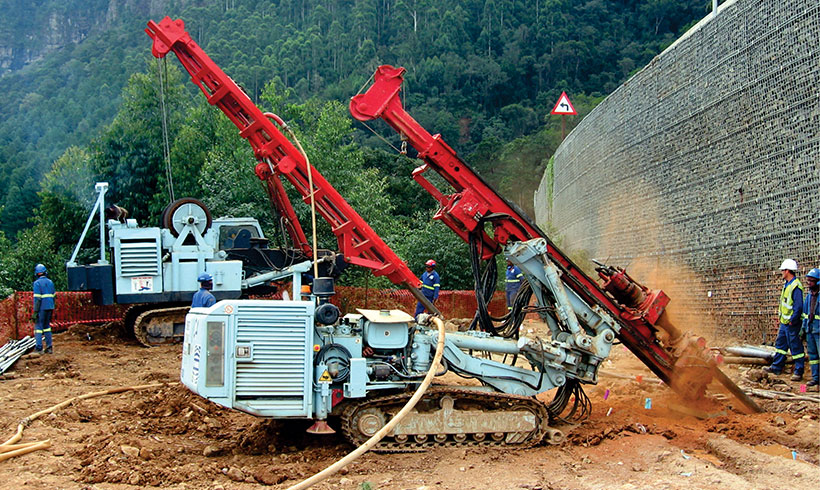A Biased View of Geotechnical Engineering For Construction Projects
A Biased View of Geotechnical Engineering For Construction Projects
Blog Article
Getting The Geotechnical Engineering For Construction Projects To Work
Table of ContentsSome Of Geotechnical Engineering For Construction ProjectsSome Ideas on Geotechnical Engineering For Construction Projects You Need To KnowThe 5-Minute Rule for Geotechnical Engineering For Construction ProjectsThe Basic Principles Of Geotechnical Engineering For Construction Projects The Definitive Guide for Geotechnical Engineering For Construction ProjectsHow Geotechnical Engineering For Construction Projects can Save You Time, Stress, and Money.
The duty of geotechnical design dramatically takes care of recognizing the attributes of dirt and rock, which might differ substantially by their thickness, wetness content etc. These attributes should be analyzed by geotechnical designers to forecast their movements under numerous situations. The security along with stability of structures are impacted by soil conditions, making this evaluation necessary., in enhancement to just how they communicate with building and constructions that have been set up on or within them, is one of the main descriptions for why geotechnical design is crucial.
Environmental protection is completed via geotechnical design. Experience in air, water, and dirt quality maintenance is placed to use by geotechnical designers to decrease the negative impacts of projects.
To sum up, geotechnical design is an important discipline that preserves the strength and stability of civil framework. Geotechnical engineers contribute to making structure tasks reliable all over the world by understanding the practices of planet materials and applying ideal planning methods.
The smart Trick of Geotechnical Engineering For Construction Projects That Nobody is Discussing
By examining soil, rock, and subsurface conditions, geotechnical engineers provide essential understandings that assist in the style, building and construction, and maintenance of buildings and framework.

Little Known Facts About Geotechnical Engineering For Construction Projects.
Lab screening: Determining the residential or commercial properties of dirt and rock. A number of top-level building and construction tasks have actually efficiently made use of geotechnical engineering to ensure their security and security.
As a leader in geotechnical design, BECC Inc. is devoted to providing ingenious and reliable services that satisfy the greatest standards of top quality and safety. For even more information on how BECC Inc. can sustain your next construction task, call us today and let us assist you develop on solid ground.
William Rankine, an engineer and physicist, established an alternative to Coulomb's earth stress concept. Albert Atterberg developed the clay uniformity indices that are still used today for dirt classification. In 1885, Osborne Reynolds acknowledged that shearing causes volumetric expansion of thick materials and contraction of loosened granular products. Modern geotechnical engineering is said to have actually started in 1925 with the magazine of Erdbaumechanik by Karl von Terzaghi, a mechanical designer and geologist.
Not known Incorrect Statements About Geotechnical Engineering For Construction Projects
Terzaghi additionally created the framework for concepts of birthing capability of foundations, and the concept for forecast of the price of settlement of clay layers as a result of debt consolidation. After websites that, Maurice Biot completely developed the three-dimensional dirt loan consolidation concept, extending the one-dimensional version formerly developed by Terzaghi to more basic hypotheses and presenting the collection of fundamental equations of Poroelasticity.
Geotechnical designers check out and identify the properties of subsurface conditions and products.
Some Known Facts About Geotechnical Engineering For Construction Projects.
Geologic mapping and analysis of geomorphology are commonly look at this website completed in appointment with a rock hound or design geologist. Subsurface exploration usually entails in-situ testing (for instance, the conventional penetration examination and cone infiltration examination). The excavating of test pits and trenching (specifically for locating faults and slide planes) may also be made use of to discover soil problems at depth. Still, they are in some cases used to enable a rock hound or designer to be reduced right into the borehole for straight visual and hands-on assessment of the soil and rock stratigraphy. Various soil samplers exist to satisfy the requirements of various engineering projects. The standard penetration examination, which makes use of a thick-walled split spoon sampler, is the most usual means to gather disturbed samples.

Commonly, the user interface's specific geometry is unidentified, and a streamlined interface geometry is thought. Finite inclines require three-dimensional versions to be evaluated, so most inclines are examined assuming that they are definitely vast and can be represented by two-dimensional models.
Everything about Geotechnical Engineering For Construction Projects
Developing the layout based on a functioning theory of behavior prepared for under the most potential problems. Option of amounts to be observed as building earnings and calculating their prepared for values based on the functioning theory under the most undesirable problems.
Measurement of quantities and analysis of over here real conditions. Layout adjustment per real problems The empirical approach appropriates for building that has currently begun when an unanticipated growth takes place or when a failure or mishap looms or has already taken place. It disagrees for jobs whose layout can not be changed during construction.
Report this page